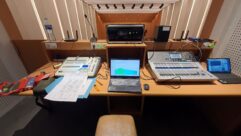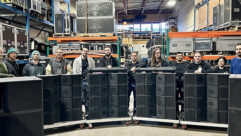
Sound Advice: Club Wars Heat Up
Oct 1, 2008 12:00 PM,
By Dan Daley
Nightclubs battle for supremacy by using sheer amplified power.
Sidebar

Boston-based JVN Systems designed and installed the sound system for rapper Jay-Z’s 40/40 club in Las Vegas. One particularly tricky mission was to keep the club’s massive bass frequencies from invading other neighboring spaces that are also housed in the
$1.9-billion Palazzo hotel.
A nightclub used to be judged on nuance as much as bombast. Jazz aficionados can tell you where the sweet spot is in the Blue Note on West 3rd Street in Manhattan or where Harry James would hang out at the old Roseland Ballroom, looking for hot new players for his orchestra. In today’s mammoth danceterias, you’re more likely to lose your hearing while also risking organ damage from high SPL.
A seemingly endless procession of new dance clubs in cities, resorts, and casinos are engaged in an arms race — each one has to have a sound system louder and bassier than the one before. It’s driving more than the neighbors crazy. “It’s insane, the [sound] levels that club owners can ask for,” says Dan Agne, principal in Sound Investment, which has done systems for clubs such as the Cielo in New York and the Red Rock Hotel’s Cherry Nightclub in Las Vegas. “It’s a challenge enough getting an incredibly loud system to sound good with high-quality music playing through it — try it with MP3s some time.”
TAKING ON THE CHALLENGE
At the Lava danceclub in the Turning Stone resort, a swank vacation spot in upstate New York, the owners asked Nathan Powell, president of integrator PTC Group of Philadelphia, for a loud sound system that not only sounded good but would also be virtually invisible to patrons. After shooting the room with EASE Focus modeling software, eight JBL PD5322 loudspeakers were placed in soffits in a balcony that rings the circular dance floor. This positioning helped achieve the goal of invisibility and kept direct sound from surfing the focused, domed ceiling. But the downward direction of the loudspeakers meant that direct sound could hit the hardwood dance floor, creating reflections.
“We had covered the walls and columns in the space with sound-deadening material, using battens and other treatments, to the point where you could not have a conversation across the room, it was so dead,” Powell says. “But the dance floor was still a challenge.” The solution was to aim the loudspeakers, sitting 12ft. above and 4ft. back from the dance floor, at a virtual point 4ft. above the raised 25ft.-diameter floor. “That way, the pattern is just barely skimming the floor,” he says.
The circular nature of the array also meant that direct sound waves could intersect. The solution was to send a left/right signal to alternate loudspeakers, and to use the BSS Audio Soundweb London processor programmed by noted acoustical analyst Steve Dash using an EAW SMAART (System Measurement Acoustic Analysis Realtime Tool) system, to create a phase-canceling effect.
JBL ASB6128 subwoofers were positioned inside the perimeter wall around the floor and focused on the dance floor, with delays applied to the PD5322 loudspeakers to ensure coherency. This configuration also creates a kind of sonic curtain around the dance floor that is dramatic and allows the overall volume level to be kept sane while still giving patrons the perception of very high volume. The system has been run at 110dB, but it is optimized for about 105dB to 106dB. Another way to rein in volume was to acoustically isolate the DJ booth and give it its own separate sound system using a pair of JBL PRX518S subs inside the booth. “DJs are notorious for turning up the level, so we gave them their own system that’s set to ride up to 5dB above the rest of the room,” Powell says. “The DJs get the energy they need without blowing out the room.”
Sound Advice: Club Wars Heat Up
Oct 1, 2008 12:00 PM,
By Dan Daley
Nightclubs battle for supremacy by using sheer amplified power.

Integrator BML-Blackbird not only provides the AV/lighting system for New York’s
Espace, it is also a business partner.
WHEN GOOD ROOMS GO BAD
John Lyons, owner of John Lyons Systems in Boston, is unique in that he is also a principal in the Lyons Group, which owns and operates 35 clubs in the United States. But experience doing systems for venues such as the first six House of Blues clubs, Jet and Tao in Las Vegas, and The Abbey and Social Hollywood in Los Angeles, has given Lyons a good eye for what a club needs. When his company acquired The Palace, a former-vaudeville-house-turned-disco that he would rebrand as Avalon Hollywood, the previous owner had already installed a new live sound system in an unsuccessful bid to rehabilitate the venue’s reputation for lo-fi live sound. “It turns out that the sound system was fine — it was the room that was the problem,” Lyons says, noting that the reverberance that made it a good vaudeville hall worked against it for amplified sound. He applied 3in. of foam soundproofing to all exposed surfaces, and that provided the perfect bed for both of the sound systems installed there. “That’s another trick — a sound system that’s optimized for live music is not going to work well for dance music and vice versa,” he says.
In this case, the live sound system is composed of an EAW KF760 line array powered by Crest Audio and Crown amplifiers. It is processed via a Soundweb London and mixed through a pair of Midas Heritage 3000 consoles. The dance music system is an EAW Avalon system that Lyons developed with EAW for his first Avalon club in Boston. “We needed two systems because dance and live music have very different requirements,” he says. “Live music needs accurate reproduction of what the musicians are playing on stage. Dance music, on the other hand, isn’t about accuracy; rather, it needs to have certain parts of the frequency band exaggerated, usually in the low and low-mid ranges.”
Thus, though both systems use the same kind of amplifiers and processing, the biggest differentiation is in the low-frequency components. The live system includes 10 EAW SB850 dual-18in. radiating subs, housed in Martin Audio boxes, that have even coverage throughout the LF spectrum. The dance system uses the EAW Avalon DCS2 horn-loaded subs that are honked between 40Hz and 60Hz. The low-mid range is boosted by the use of EAW DC1 boxes that have a 4:1 low-mid/high component ratio: four 15in. woofers for each midrange cone and HF compression driver. “This combination boosts the sound where dancers want to hear it, so they don’t have to have the volume of the entire system and frequency spectrum increased,” Lyons says.
20/20 FOR 40/40
Vito Randazzo is proud of the system that his company, JVN Systems, designed and installed for rapper and urban entrepreneur Jay-Z’s 40/40 Club in Las Vegas. The self-powered Meyer Sound system uses nine curvilinear Meyer M’elodie loudspeakers in the main dance room with processing by Meyer’s Galileo loudspeaker-management system and power for the private room’s loudspeakers from Lab.gruppen C20:8X 8-channel amplifiers. A system of this magnitude underscores the fact that the war isn’t just between competing clubs, but between the sound systems and their users as well.
The installation of the system was concurrent with the construction of the club late last year at the Palazzo hotel — the 50-story, $1.9-billion tower and casino attached to the Venetian hotel. Combined with the 4,050-room Venetian, the Palazzo’s 3,068 rooms make the combined resort the largest in the world under one roof. Installing a sound system while walls are still going up and under a tight deadline presents its own challenges, and it meant that the final ring-out of the system could not be done until construction was finished, just before the club’s Dec. 30, 2007, opening party.
Sound Advice: Club Wars Heat Up
Oct 1, 2008 12:00 PM,
By Dan Daley
Nightclubs battle for supremacy by using sheer amplified power.
In the meantime, Randazzo focused on containing the club’s huge bass and not letting it invade neighboring spaces. Four Meyer 700-HP subs were stacked two per side inside cavities carved out of the club’s walls. The cavities were lined with heavy-duty industrial acoustical foam and the boxes built to line the cavities were made as airtight as possible. “Low frequency always looks for a way to escape, so we had to make these enclosures as tight as possible,” Randazzo says. “For that same reason, we designed the boxes so that they were flush with the subs themselves. We wanted no place for the low-frequency energy to have a chance to slip through. We wanted to be able to direct that energy as much as physics allows in order to control it in the room and to keep it from getting into other areas of the hotel.”
It was a noble goal, but one not attained immediately. Morels, the ultra-high-end French steakhouse one level above the club, issued a stream of complaints about vibrations coming from below. The problem was less LF energy leakage than simple mechanical coupling between the walls and floors. That was able to be largely addressed after the room could be properly analyzed and the resonant frequencies identified and attenuated through notching on the Galileo’s EQ. “The Meyer is pretty flat to start with, but once we were able to flatten the room out completely, the problem largely went away,” Randazzo says.
But what isn’t going away any time soon is the tendency on the part of DJs to try to push the limits of the system and the room. “It’s a constant tug of war between what the system can do and what the DJs want it to do,” Randazzo says. An Aphex Systems 720 Dominator II limiter had been installed as a governor on the overall system and was located in a locked rack, supposedly inaccessible to visiting DJs. But a service call revealed that at least one DJ had been able to break the collar around the rack and access the compressor, which was effectively bypassed, allowing the sound in the room to reach 116dB, which blew the cones out on four of the M’elodie loudspeakers.
“At this point, it’s just noise, no matter how good the system is,” he says. “But you can’t tell that to a DJ, who just wants to feel the low end, or even sometimes to the client, who wants the DJ to be happy so the patrons are happy. It’s easier for them to blame the sound system than the DJ, and I understand that. But it doesn’t change the fact that you’re asking the system to do more than it’s designed to. That’s the club wars.”
Only In New York
For much of the century, New York City has been on a club tear. New discos popped up weekly in trendy neighborhoods such as Chelsea and the Flatiron District. When corporate ownership spotted the trend, it went into even higher gear. Clear Channel spinoff Live Nation took on the Roseland Ballroom and the Fillmore New York (actually the old Irving Plaza, rebranded and refurbished), as well as 600-seat Blender Theater on East 23rd Street and the Luna Lounge in suddenly-you-can’t-find-parking Williamsburg, Brooklyn. Other once-grungy/hip properties such as the Bowery Ballroom and Mercury Lounge were resurrected as brands as the live-music industry picked up the slack for the record business.
But just as suddenly, a couple of years ago, the city put on the brakes; a condo market seemingly immune to the crash-and-burn of the rest of the country was making New York real estate too valuable for discos. But that’s not stopping the clubbers. The latest trend is temporary event spaces: a disco one night, a fashion show the next, and a movie premiere on the weekend, followed by a corporate shareholders meeting on Monday. They all need installed sound, and it has created a unique business proposition for systems integrators.
At Espace on West 42nd Street, AV/lighting systems provider BML-Blackbird is not only the systems provider and integrator, it’s also a partner in the business. The space is filled with JBL VRX loudspeakers, Crown Audio CDi 4000 and 6000 series amplifiers, and the occasional Yamaha PM5D digital console, as well as moving lights — all of which BML-Blackbird installed and maintains at its own cost. The payoff comes when the building owner splits the take from each rental 60/40 with Blackbird. Exact amounts are not discussed, but it’s widely agreed upon that some spaces make their nut in a single evening. It’s a scenario played out all over Manhattan every night, with major systems providers partnering with spaces such as the Toy Center, Espace, and Cipriani to create a menu of venues for any type of event — all of which clamor for high-end, high-dollar audio.
“One of the big challenges is creating a sound system that sounds as good as the best club systems, is as loud as the best club systems, has huge low end for disco nights, and excellent intelligibility for corporate meetings,” says Donny Quinton, senior audio engineer for BML-Blackbird, which also partners with promoters at Capitale and Gustavinos. “It’s not like you do a club, you leave. This is an ongoing thing.”
Nothing about these spaces is conventional. Capitale was originally designed as a disco and thus needed a lot of audio firepower, in the form of 16 JBL Vertec PA boxes, arranged in clusters of four each in each corner of the room. The system is the size of a small touring rig, powered by Crown Microtech 5002 amplifiers and using BSS London loudspeaker control, Klark-Techik DN3600 processing, and a Crest X console. The space has hosted shows by A-list performers such as Wyclef Jean and Gnarls Barkley. “It can be insanely loud,” Quinton says, but it still manages to skirt the noise restrictions on clubs by virtue of its official status as a catering hall with a cabaret license, which permits music.
Part of BML-Blackbird’s side of the equation was running additional cabling into the space, enough to have 32 pairs of multicore Belden cable feeding boxes on each wall. “We never know where each event is going to want audio coming from, whether it’s a DJ or a live band or loudspeakers,” Quinton says.
Acoustical issues have been resolved in ways more familiar to Tony Soprano than John Storyk. When a 10th-floor resident at the condo on far West 42nd Street whose basement houses Espace complained about low-frequency noise, the promoter offered tickets to a Broadway show on nights the space is used for loud events. “Just like that; no more noise complaints,” Quinton says.
Welcome to New York.
— D.D.










